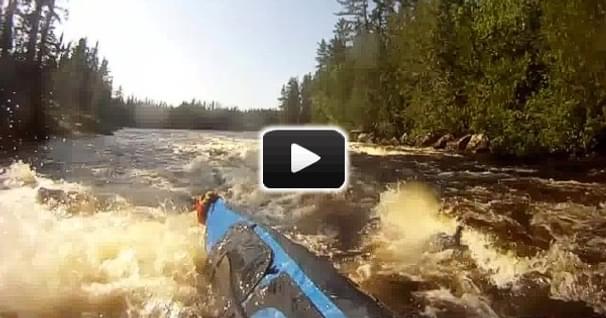Self-Rescue: Swimming
There are two ways of swimming through a rapid. You can swim defensively or offensively. Defensive swimming is also referred to as "body surfing" and involves floating downstream in a protected position: lying on your back, feet downstream, arms out to the side and with your whole body floating as close to the surface as possible. This is the best swimming position to assume if your goal is to ride out a rapid, or if you're in shallow water and worried about hitting rocks. You can also back ferry from this position, but it is not an effective way of moving in whitewater.


If you need to get somewhere fast, then you'll adopt the offensive swimming technique. Offensive swimming involves getting on your stomach and swimming hard with the front crawl technique. You swim aggressively to get to shore in deep enough water, cross eddy lines and to stay afloat in boils or whirlpools.
Swimming through Holes
If you find yourself swimming into a hole, you need to understand that the only way you're going to get through the hole is to hitch a ride with the green water that flows beneath it. If you try to stay on the surface, you'll run into the foam pile and you could get stopped and stuck there momentarily or longer. This means that when you float into a hole, you want to stay low and let yourself slide under the foam pile. If the hole looks nasty enough, you may even want to give yourself a little push underwater. Of course, you need to be careful that you don't push yourself too deeply, because holes often indicate relatively shallow areas. If you push yourself too deeply you could end up bouncing off the river bottom.
TAHE 10'6 & 11'6 SUP-YAK Inflatables
2-in-1 Kayak & Paddle Board complete packages for single or tandem use.
Swimming Out of Holes
Although a swimmer will get washed downstream quite quickly out of most holes, there are some holes that have the potential of holding a swimmer for extended periods of time. If you find yourself caught swimming in a nasty hole, then you again need to remember that the escape route is below you, in the green water that is flowing under the backwash and downstream. This means that you need to fight the urge to stay on the surface and should aggressively push yourself downward or tuck into a ball and let yourself sink.

Swimming over Strainers
Strainers are obstacles, or collections of obstacles, such as trees, which let water through but stop large objects, such as paddlers or swimmers. If you were ever to find yourself in a situation where you are swimming into a strainer and it can't be avoided, you need to get on your stomach and swim hard towards it. When you reach it, lunge with all of your might and crawl your way over the top. The key is being aggressive and not wavering. Once you are washed under a strainer, things are much harder to control.
This article is an excerpt from Ken Whiting's revised book, 'The Ultimate Guide to Whitewater Kayaking - 2nd Edition'
Ken is a World Champion Kayaker and the author and producer of an award winning series of instructional kayaking books and videos. He was recognized by "Paddler Magazine" as one of their 'Paddlers of the Century'. For more information, visit www.helipress.com.
Related Articles
In my opinion, the wet exit is the important overlooked skill in kayaking because it can really help…
One of the important facets of swimming in whitewater is being able to catch eddies correctly. If…
Okay, well, we got another big rapid here. Seems the lower portion of the rapids section on the Kesagami…



